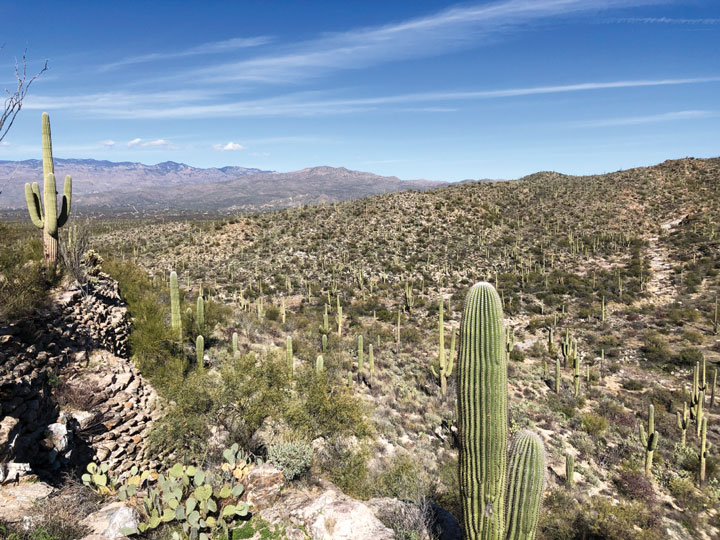A full-time RVing couple makes the most out of travel restrictions during the height of COVID-19
Much has been written over the years about RV lifestyles, the myriad places to visit, hidden treasures to discover, and the variety of equipment available with which these adventures can be accomplished and enjoyed. But the arrival of COVID-19 reordered many aspects of life in our country, including the RVing world. For us, as full-timers, this has been a learn-as-you-go adventure.
The chronology of our trek, navigating an evolving “new normal” on the road this year, confirms that we have good reason to remain guarded and cautious in our travels and planning. But our experiences also prove that RVing continues to offer access to many wonderful journeys and destinations, and may, in fact, emerge as one of the better prescriptions for recreational activity during this challenging time.
December 31, 2019 – The World Health Organization (WHO) is informed of a pneumonia of unknown cause, detected in the city of Wuhan, China.
Our second year of full-time RVing begins in early January as we depart Massachusetts, our brand-new Montana fifth-wheel in tow. Our route will take us quickly south to escape the New England winter, and then far west to revisit some favorite locations and a number of places we missed during our 10,000-mile inaugural journey the previous year.
We enjoy the planning process, and since our itinerary includes many popular destinations, we are armed with campground reservations extending through the year and into 2021. Little do we know that as our wheels make their first revolutions of the journey, events already in play on the other side of the world will soon reach out to significantly alter our course.
While we do not think of ourselves as snowbirds, per se, our itinerary could possibly earn us that moniker. We pass much of the winter in the desert Southwest. Tucson, Arizona, is a highlight for us with its temperate climate and outdoor activities. For bicyclists, “The Loop” is a 120-mile-plus system of paved pathways and buffered bike lanes that circle the city, accessing trail heads, parks, shopping and entertainment. Nearby Saguaro National Park offers camping, hiking and stunning desert vistas, dominated by iconic Saguaro cacti.
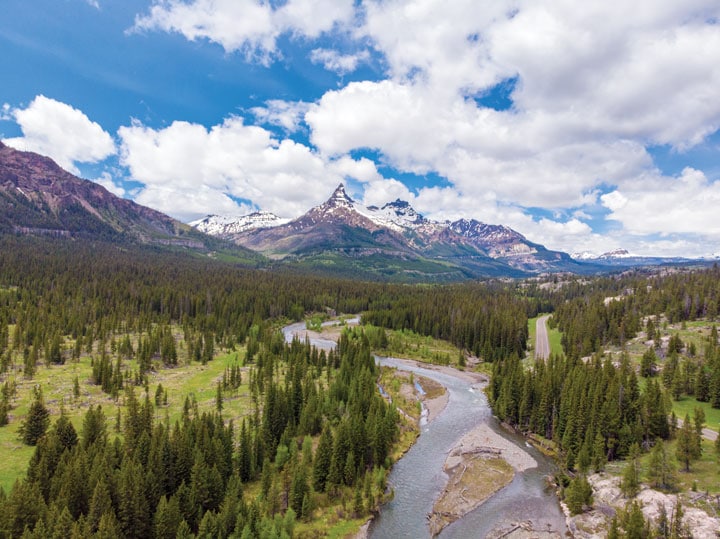
Snowcapped Pilot Peak and the Clark Fork River along the Wyoming stretch of the scenic Beartooth Highway. Photos by Tom and Jan Dougherty
February 11, 2020 – WHO names the new virus COVID-19 using guidelines requiring that it be easily pronounceable and not refer to any place, animal, individual or group of people.
In late February, after soaking up an adequate amount of desert sun, we head for California and our first stop there, Paso Robles. “Paso,” as it is referred to by locals, lies inland from the Pacific Coast about halfway between Los Angeles and San Francisco. This thriving grape-growing region is a must for wine enthusiasts and its proximity to the coast offers outstanding scenery and interesting destinations such as the famous Hearst Castle (not open at this writing) in San Simeon. Here, also, is Piedras Blancas Rookery where you can watch elephant seals year-round in their natural environment. The dirt parking lot is right off the coast and easily accommodates any size RV.
February 29, 2020 – Washington state reports the first COVID-19 death in the United States.
The climate in Paso Robles at this time of year brings comfortable days and cool nights. It is the rainy season, but this year has been relatively dry to date. We take advantage of the weather and enjoy picnics, visits to wineries and other area attractions. At this point the virus is little more than background noise to us.
March 4, 2020 – California reports its first COVID-19 death. Governor Gavin Newsom declares a State of Emergency to help prepare for a broader spread of the disease.
Among other activities, our RV park in Paso hosts weekly wine tasting parties which attract seizable crowds. There is live music, craft tables are set up for the kids, grills are available for food prep and firepits help keep us warm. It is one of the best socializing events we have encountered in any campground and we enjoy meeting and chatting with fellow RVers from around the country. For the first time, however, we agree that it is best not to shake hands with others.
March 11, 2020 – The World Health Organization characterizes COVID-19 as a pandemic.
As news about the virus percolates and begins dominating discussions, we consider the possibility of altering our itinerary. We decide to cancel plans to visit with friends and family in the San Francisco area and proceed directly to our next destination farther north and away from cities.
The Mendocino Coast, about 150 miles north of San Francisco, is one of California’s gems. With its many state and county parks, miles of scenic shoreline and ageless forests of stately redwoods giving texture to the coastal hills, it is truly an idyllic destination. The small town of Mendocino is an eclectic, arty community with architecture hearkening back to the mid-1800s Gold Rush era. Its bucolic, coastal setting has made it a frequent location site for movies and television productions.
We have visited this area regularly for nearly 40 years, but this will be our longest stay and our first time with an RV. We arrive at our campground on March 17 looking forward to our monthlong visit and the opportunity to fully enjoy these beautiful environs.
March 19, 2020 – Governor Newsom issues “stay at home” order for California, the first state to take such action. There is no set expiration date for the order. Across the country other states soon follow California’s lead.
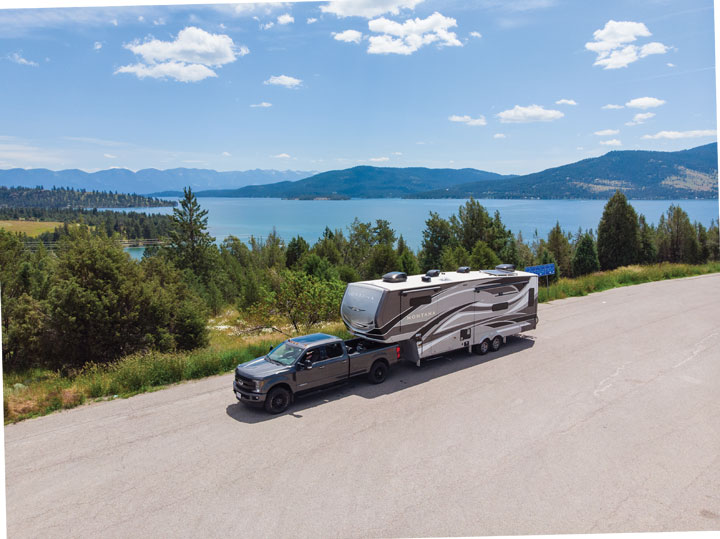
The authors’ Montana fifth-wheel in the foreground of northwest Montana’s Flathead Lake — the largest natural freshwater lake west of the Mississippi.
Our arrival in Mendocino prior to the issuance of the stay-at-home order appears to be fortuitous for us. California has granted individual counties the authority to add and enforce constraints above and beyond the state order, and Mendocino County has enacted very tight restrictions, essentially banning any “transient” visitors. Hotels and inns shut down and area campgrounds close to any new arrivals. At this juncture, existing campground guests are allowed to “shelter in place,” so, for now, we feel secure.
Quickly, all state and local parks and beaches are closed to the public and only “essential” businesses and services remain open in the area. Mendocino, normally a vibrant tourist destination, is now like a ghost town. Our activities are limited to drives up and down the coast, walks around town and periodic outdoor get-togethers with friends for cocktails and “social distance” conversation. Most of our remaining campground neighbors are California residents who choose to pack up and return to their homes to wait things out.
The headlines are getting worse by the day and it appears evident that our country is ill equipped and unprepared for this viral onslaught. We pay particular attention to information regarding how states and localities are dealing with campgrounds and RV parks. The news we hear is not good, with frequent mention of statewide closures and even evictions of campground residents. Because we are full-time RVers with no other home to retreat to, these draconian measures make us anxious about our future travels and security. Our current situation, however, seems stable and we remain in place for the duration.
May 4, 2020 – Governor Newsom issues Executive Order informing local health jurisdictions and industry sectors that they may begin a gradual reopening process, starting May 8, with specified restrictions.
We are now 47 days into the “lockdown” and several weeks beyond our originally planned departure date from Mendocino. National Park closures have caused us to cancel visits to Yosemite, Bryce and Zion that were planned for this time frame and we are now focused on reaching Montana by mid-May to intersect with our original itinerary.
Our principal concern is whether campgrounds along our route and at our destination will be in operation. Phone calls to these locations indicate that they are open, so, with trepidation, we depart California, transit Nevada and Idaho and arrive in Montana on May 18.
Montana’s population has, to date, been relatively free of COVID-19 and Phase 1 reopening is well underway by the time we arrive. There remains, however, a 14-day self-quarantine requirement for “non-essential” visitors to the state. We intend to be in Montana until late July, dividing our attention between Yellowstone and Glacier national parks, two of the most popular destinations in the park system, but, as yet, neither of them is open.
May 19, 2020 – Montana Governor, Steve Bullock, announces plan to enter Phase 2 of reopening beginning June 1.
Montana’s access to Yellowstone starting June 1 coincides with the conclusion of our quarantine period and, despite limitations in services and amenities, we are eager to spend time in the park. Our excursions there during the next few weeks prove surprisingly quiet with no tour buses and relatively few visitors in evidence. We enjoy the resultant ease of access to the park’s many impressive sights, including an almost private showing of Old Faithful. We anticipate, however,
that with the general easing of restrictions around the country and warming weather, Yellowstone’s attendance will soon ramp up.
As June concludes, we reposition to West Glacier in the northwestern part of the state. The majestic beauty of Montana is perhaps nowhere more evident than in this region where several Rocky Mountain ranges and numerous lakes are testimony to the effects of eons of glacial and tectonic activity on the landscape.
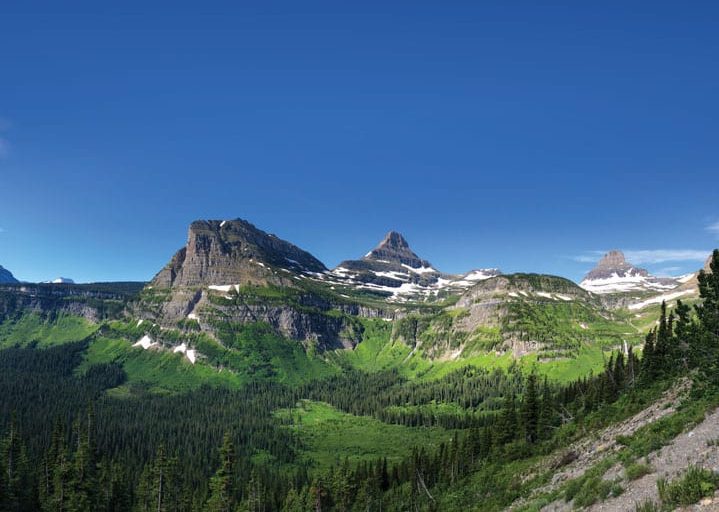
NATURAL WONDER The Going to the Sun Road transects Glacier National Park. The often- serpentine trek awards visitors access to some of the most beautiful scenery in the Rocky Mountains.
Glacier National Park, one of the most visited in the park system, encompasses a million acres of this wilderness and is home to hundreds of towering mountain peaks, lakes and waterfalls. True to its name, there are 25 named active glaciers in the park, and with more than 700 miles of maintained trails, Glacier is a hiking mecca. We now understand why so many RVers we have met in our travels have said, “You have to go to Glacier!”
Our campground is quite full as we approach the Fourth of July weekend, and we are told that there is a waiting list of several hundred RVers looking to spend some time here this summer season. The pools and other amenities are open and well-attended. If not for the masked office staff one might think that the pandemic had just been a bad dream.
Although it is refreshing and uplifting to hear the cacophony of kids and adults at play, we remain concerned about the potential risk associated with such gatherings and interactions. We choose to avoid these activities and continue to social distance and wear our masks as appropriate.
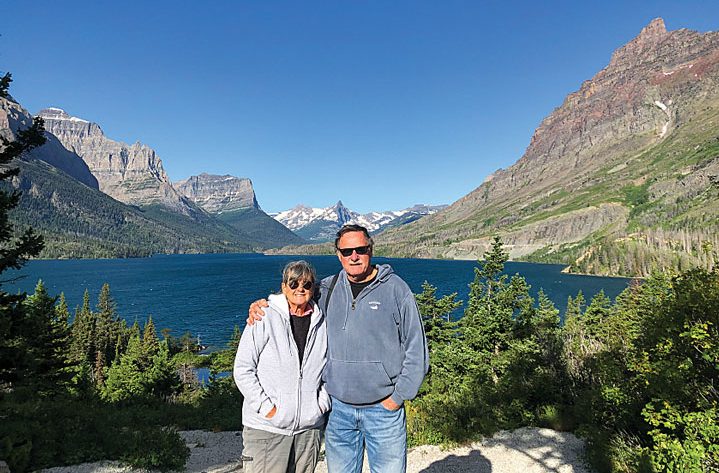
Authors Jan and Tom Dougherty stretch their legs and enjoy the crisp air in eastern Glacier National Park with Saint Mary Lake providing a postcard backdrop.
July 24, 2020 – Massachusetts Governor, Charlie Baker, signs an executive order, effective August 1st, requiring all people arriving from outside the state (with some exceptions) to comply with a strict 14-day quarantine.
Our time in Montana will soon end and we will begin our migration back to the Northeast where it appears we will once again have to endure a quarantine protocol before we can visit with family and friends.
We continue with preparations for our next expedition, although we are now more mindful of how unforeseen events can affect even the best-laid plans.
So far, this year’s travels have not been without adversity and a measure of angst, but we still manage to find great enjoyment in our journey that has instilled a measure of optimism for the future. We are encouraged that, going forward, all of us in the RVing community, whether full-time or recreational, will have continuing opportunities to travel safely and fully experience the lifestyle and all the enjoyment it offers.
Campground Owners’ Perspective
An interview with Pam and Chan Libbey of Yellowstone’s Edge RV Park
Dealing with the pandemic has not only been a challenge for RVers, but for campground owners and operators as well. Montana’s restrictions have been less severe than in some states but have still created significant challenges. We visited with our hosts, Chan and Pam Libbey, at Yellowstone’s Edge RV Park to discuss their experience. The Libbeys have owned and operated the campground for 27 years. It is a picturesque Good Sam Park set along the banks of the Yellowstone River in the Paradise Valley, south of Livingston, Montana, and a short drive north of Yellowstone National Park.
“We have a short window of business opportunity due to the climate,” noted Pam. “Opening day was May 1st, and we lost a lot of sleep in March and April worrying about whether it was right to open or not.”
The park received a high volume of calls and emails from clientele regarding the campground’s status and also seeking advice and guidance about RV travel issues. “I felt like I had earned a degree in counseling,” mused Pam.
Many procedures had to be developed or adapted at the park for the safety and security of guests and staff. Consultation with a reputable local janitorial company yielded proper sanitation practices and access to appropriate cleaning supplies. Seasonal park workers from out of state were required to arrive 14 days early in order to conform to Montana’s quarantine requirements. A curbside check-in option was instituted and protective screening was erected for office staff, among other measures. Unfortunately, the toilet paper supply void prohibited them from opening the bathhouse until availability recovered. This meant only RVs with facilities could be accommodated during this period.
Also of significant concern was the status of Yellowstone National Park, which was still closed at the time of the campground’s opening on May 1st. Uncertainty about Yellowstone’s opening resulted in a cascade of cancellations. Yellowstone lies within three states — Montana, Wyoming and Idaho — and the bureaucracies of these states, along with park management, were having difficulty arriving at a cohesive reopening plan. Ultimately, each state pursued its own agenda. Montana finally opened its gates to the park on June 1st, the last of the bordering states to do so. This delay caused additional cancellations for the campground.
The Libbeys’ commented that in June and Phase 2 of Montana’s reopening progression, the campground had returned to a more familiar level of activity and had been full on several occasions. The “new normal” for RVers and campgrounds has yet to be fully defined, but Pam noted that so far, all seemed to be going well with behavior and compliance to new rules. “RVers are safe people,” she emphasized. We echo her sentiments and were certainly grateful for our time in this lovely, safe haven.

